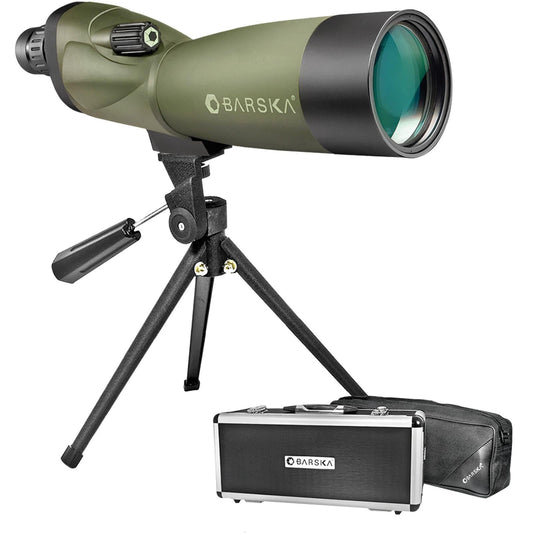

Barska Blackhawk WP Spotting Scope Tripod Soft & Hard Case - 20-60x60mm Matte provides exceptional clarity and versatility for outdoor enthusiasts. Designed for activities such as birdwatching, hunting, and stargazing, this spotting scope features a magnification range of 20x to 60x, allowing you to see distant subjects clearly. The 60mm objective lens ensures superior light transmission and color accuracy, enabling clear viewing in various lighting conditions.
Equipped with a sturdy tripod, this scope offers stable viewing, eliminating the shakiness that can occur with handheld models. Its rugged, waterproof construction ensures durability in tough weather, making it an excellent companion for all your adventures. A soft carrying case is included for easy transport and protection during travel, ensuring your scope stays safe and ready for use.
Key Features:
- ENHANCED CLARITY for hunting at dawn, ensuring you spot your target with ease.
- STURDY TRIPOD included for stable viewing, perfect for long hours in the field.
- RUGGED DESIGN that withstands tough weather conditions, keeping your scope safe.
- PHASE-COATED PRISMS provide brilliant colors and sharp images for impressive clarity.
- PORTABLE SOFT CASE protects your scope while traveling, making it easy to transport.
- USER-FRIENDLY CONTROLS allow for quick adjustments, so you can focus on what matters.
- LIGHTWEIGHT MATERIAL makes it easy to carry, ideal for adventurous outings.
- VERSATILE USE for birdwatching, hunting, or even watching sports from a distance.
Technical Specifications
| Specification | Details |
|---|---|
| Magnification | 20-60x |
| Lens Diameter | 60mm |
| Weight | 3.5 lbs |
| Dimensions | 14 x 5 x 5 inches |
| Material | Waterproof, Fogproof |
What’s in the Box?
- Barska Blackhawk WP Spotting Scope
- Pan-Head Lever Tripod
- Soft Carrying Case
- Lens Covers
- User Manual
Customer Reviews
"This spotting scope is incredible! I can finally see birds clearly from afar!" - Sarah M.
"The tripod is solid, and I love the soft case for travel. Highly recommend!" - John D.
FAQ
What is the maximum range of this spotting scope? The Barska Blackhawk WP Spotting Scope can magnify from 20x up to 60x, ideal for long-distance viewing.
Is it waterproof? Yes, this spotting scope is designed to be waterproof and fogproof for durability in various weather conditions.
How do I clean the lenses? Use a microfiber cloth and lens cleaner to maintain clarity without scratching the surface.
Can I use this for stargazing? Absolutely! Its powerful magnification and clarity make it suitable for celestial observations.
How does this compare to other brands? The Barska Blackhawk offers exceptional features at a competitive price, making it a great choice among similar models.
Similar Models
Looking for more optical options? Explore our extensive collection of Barska products to find perfect binoculars and additional spotting scopes tailored to your adventures. Don't miss out on discovering the excitement of the outdoors with the right gear!
You May Also Like
Here’s some of our most similar products people are buying. Click to discover trending style.






